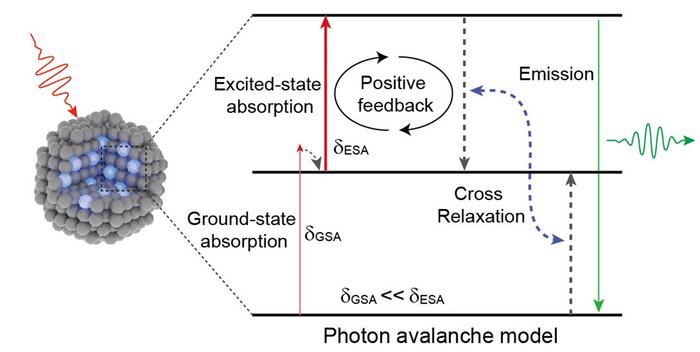
In a groundbreaking development poised to redefine the landscape of optical materials, researchers at the National University of Singapore (NUS) have engineered a novel class of lanthanide-doped nanomaterials showcasing optical nonlinearities surpassing a staggering magnitude of 500. This unprecedented achievement sets a new frontier in photon avalanche nanophotonics, promising to overhaul conventional approaches in optical sensing, imaging, and quantum photonics applications.
Photon avalanche, a rare and powerful photophysical phenomenon, diverges fundamentally from conventional fluorescence behaviors through its exceptionally nonlinear emission response to light excitation. Unlike linear fluorescence where emitted light intensity directly correlates with the excitation source, photon avalanche systems undergo a dramatic, abrupt surge in emission intensity once the excitation threshold is crossed. This effect is analogous to a runaway chain reaction or avalanche, propelled by intricate energy transfer dynamics within the material, amplifying light output exponentially rather than incrementally.
Central to this advancement is a meticulous redesign of lanthanide-doped nanocrystals, achieved through sublattice reconstruction by substituting lutetium ions within the crystal lattice framework. This subtle yet profound alteration induces significant local crystal field distortions, effectively enhancing interionic interactions that are pivotal for photon avalanche phenomena. Such structural manipulation enables a robust positive feedback loop among excited-state absorption (ESA) and cross-relaxation (CR) processes involving thulium ions (Tm³⁺), which mutually reinforce each other to escalate the excited-state population exponentially.
.adsslot_zE3muqZ2G9{width:728px !important;height:90px !important;}
@media(max-width:1199px){ .adsslot_zE3muqZ2G9{width:468px !important;height:60px !important;}
}
@media(max-width:767px){ .adsslot_zE3muqZ2G9{width:320px !important;height:50px !important;}
}
ADVERTISEMENT
The research, spearheaded by Professor Liu Xiaogang of the NUS Department of Chemistry in collaboration with Professor Liang Liangliang from China’s Xiamen University, breaks new ground by demonstrating the capacity to engineer photon avalanche effects in nanocrystals with optical nonlinearities that leap beyond 500, a figure that eclipses prior benchmarks by an order of magnitude. This ultrahigh-order nonlinear optical response transcends limitations historically imposed on fluorescent probes and nanomaterials, ushering in new possibilities for ultrasensitive detection technologies.
At the core of the photon avalanche mechanism lies a sophisticated interplay of photophysical processes. Initially, ground-state absorption excites electrons to intermediate energy levels, which subsequently undergo excited-state absorption to higher energy states. This excited population then facilitates cross-relaxation energy transfer between neighboring lanthanide ions, effectively creating a regenerative cycle. The positive feedback loop generated between ESA and CR engenders a rapid and exponential increase in photon emission, akin to an optical cascade, which amplifies even minuscule fluctuations in excitation into significant emission shifts.
The nanoscopic scale engineering achieved by the team is particularly notable. By introducing lattice distortions at the nanoscale, the materials demonstrate enhanced energy transfer dynamics that magnify nonlinear responses. For instance, 27-nanometer nanocrystals exhibited optical nonlinearities exceeding 150, sufficient for super-resolution imaging modalities using only a single beam of excitation light. Notably, these materials achieved spatial resolution around 33 nanometers laterally and 80 nanometers axially—rivaling the performance of complex techniques such as Stimulated Emission Depletion (STED) microscopy without demanding elaborate instrumentation or high excitation intensities.
Scaling up to larger nanodisks of approximately 170 nanometers revealed even more pronounced nonlinearities exceeding 500. Fascinatingly, these larger structures exhibited spatially heterogeneous emission patterns within individual nanocrystals, enabling imaging capabilities that surpass the physical dimensions of the emitters themselves. Such spatial resolution and emission patterning introduce novel avenues for precise manipulation and detection at the nanoscale, leveraging the intrinsic nonlinear dynamics of photon avalanche materials.
The implications of this pioneering work extend far beyond imaging. The ultrahigh nonlinear response of these engineered nanomaterials opens pathways toward creating cost-effective and compact optical amplifiers capable of transducing subtle changes across a variety of stimuli—including light intensity, temperature fluctuations, and environmental variables—into amplified optical signals. These properties render photon avalanche nanomaterials ideal candidates for next-generation chemical and biosensors with extraordinary sensitivity.
Moreover, the research lays a strong foundation for advancements in quantum photonics. The precise control over nonlinear emission and feedback mechanisms underpinning photon avalanche phenomena may be harnessed to develop novel optical switches and photon sources critical for quantum information processing. The ability to spatially and intensity-specifically control emission at the nanoscale also hints at potential breakthroughs in high-density data storage and encryption technologies, where information can be encoded and retrieved through modulated optical signals with sub-wavelength precision.
Professor Liu reflects on the broader significance of the findings: “By integrating photon avalanche effects with atomically precise nanomaterials design, we are challenging the conventional thresholds of nonlinear optics. This convergence paves the way for an entirely new generation of light-driven technologies that promise unprecedented speed, compactness, and sensitivity.”
Published in the journal Nature on June 18, 2025, this research represents a milestone in photonics and materials science, potentially catalyzing a suite of technological innovations across biomedical imaging, sensing, and quantum device engineering. The combination of experimental insight and nanoscopic control achieved in this study exemplifies the growing interdisciplinarity driving modern scientific frontiers.
In conclusion, the NUS-led team’s success in pushing optical nonlinearity beyond previously attainable limits through careful lattice engineering not only enhances fundamental understanding of photophysical mechanisms but also unlocks myriad practical applications. As photon avalanche nanophotonics matures, it promises to transform how scientists and engineers exploit light-matter interactions for precision imaging, sensing, and information technologies in the years to come.
Subject of Research: Not applicable
Article Title: Optical nonlinearities in excess of 500 through sublattice reconstruction.
News Publication Date: 18 June 2025
Web References:
https://www.nature.com/articles/s41586-025-09164-y
http://dx.doi.org/10.1038/s41586-025-09164-y
Image Credits: National University of Singapore
Keywords
Physical sciences, Chemistry
Tags: advanced imaging technologiesenergy transfer dynamics in photonicsexcitation threshold effectsinterionic interactions in nanomaterialslanthanide-doped nanomaterialsnanocrystal structural engineeringoptical nonlinearities in materialsoptical sensing innovationsphoton avalanche phenomenonphotonics research breakthroughsquantum photonics advancementssublattice reconstruction techniques





